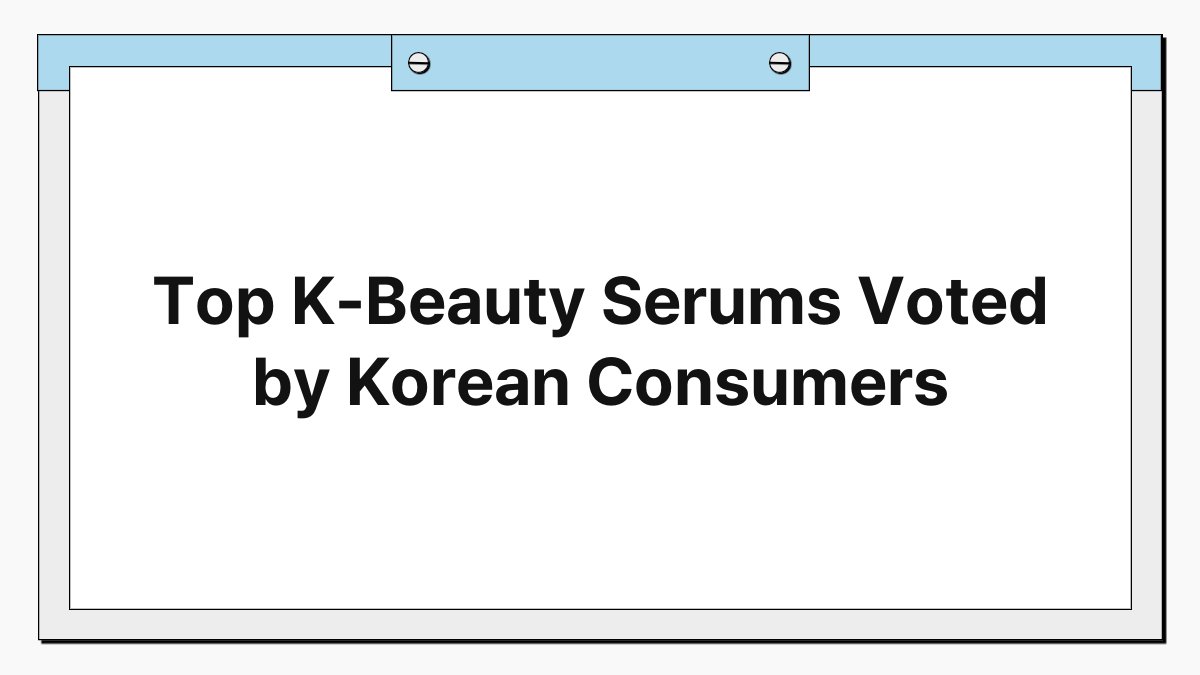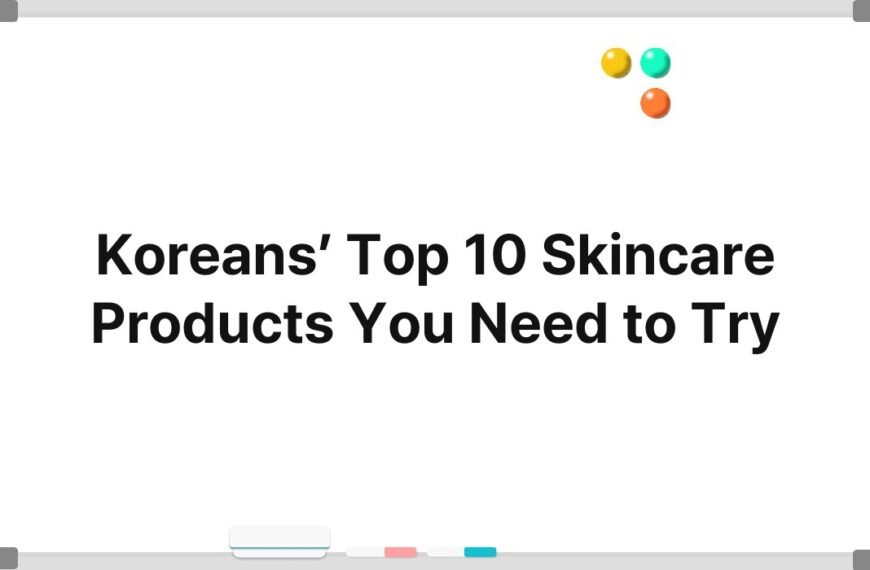[K-Bridge/Samuel] Top K-Beauty Serums Voted by Korean Consumers represent the pinnacle of skincare products, as chosen by the very consumers who use them.
These serums are celebrated for their effectiveness and innovative ingredients, catering to a variety of skin concerns ranging from hydration to anti-aging.
In a country renowned for its beauty standards and advanced skincare routines, these products have gained significant popularity and trust.
This article will delve into the top K-beauty serums that have captured the hearts of Korean consumers, exploring their key ingredients, benefits, and why they stand out in a competitive market.
The Rise of K-Beauty Serums
K-beauty serums have gained immense popularity not only in Korea but globally, as consumers seek effective solutions for their skincare needs.
The rise can be attributed to the innovative formulations and the emphasis on natural ingredients that are gentle yet effective.
Korean consumers are known for their discerning taste and high standards when it comes to skincare, which has led to a thriving market for serums that deliver real results.
These products often incorporate unique ingredients such as fermented extracts, botanical oils, and cutting-edge peptides that address various skin issues.
K-beauty serums are often lighter than traditional creams, allowing for deeper penetration into the skin.
This characteristic makes them ideal for layering within a skincare routine, enhancing the overall effectiveness of other products.
The trend has also been fueled by social media, where beauty influencers and skincare enthusiasts share their experiences, leading to increased awareness and demand.
As a result, consumers are more informed and selective, making their choices based on efficacy and ingredient transparency.
The competitive nature of the K-beauty market means that brands are constantly innovating to meet consumer demands.
This has led to the emergence of numerous serums that cater to specific skin types and concerns, from hydration and brightening to anti-aging and soothing.
By examining the top K-beauty serums voted by Korean consumers, readers will gain insights into what makes these products effective and how they can enhance their own skincare routines.
Key Ingredients in Top K-Beauty Serums
Understanding the key ingredients in top K-beauty serums is essential to grasp their effectiveness.
Many of these serums utilize unique components that are deeply rooted in Korean skincare traditions.
One of the most popular ingredients is hyaluronic acid, known for its incredible ability to retain moisture.
This makes it a staple in hydrating serums, providing plumpness and elasticity to the skin.
Additionally, the lightweight nature of hyaluronic acid allows it to penetrate deeply, delivering hydration where it’s needed most.
Another significant ingredient is niacinamide, a form of vitamin B3 that helps to brighten the skin and improve its texture.
Niacinamide is celebrated for its ability to reduce the appearance of pores and even out skin tone, making it a favorite among those with oily or combination skin.
This ingredient also possesses anti-inflammatory properties, making it suitable for sensitive skin types.
Its versatility allows it to be combined with various other ingredients, enhancing the overall effectiveness of a serum.
Lastly, fermented ingredients have gained traction in K-beauty serums for their probiotic benefits.
Fermented extracts, such as those derived from rice or green tea, help to promote a healthy skin barrier and improve overall skin texture.
These ingredients are rich in antioxidants and can enhance the absorption of other active ingredients, leading to more noticeable results.
The combination of these key ingredients in top K-beauty serums contributes to their high efficacy and popularity among consumers.
Popular K-Beauty Serums and Their Benefits
Among the top K-beauty serums, several stand out for their unique formulations and proven benefits.
The first is the Missha Time Revolution Night Repair Probio Ampoule, known for its powerful anti-aging properties.
This serum contains a high concentration of fermented ingredients, which help to rejuvenate the skin and reduce the appearance of fine lines and wrinkles.
Its lightweight texture makes it easy to layer, allowing for maximum absorption and effectiveness.
Another favorite is the Laneige Water Bank Hydro Essence, which focuses on intense hydration.
Infused with mineral-rich water and green mineral water, this essence provides long-lasting moisture, making it perfect for dry skin types.
The serum’s refreshing texture absorbs quickly, leaving the skin feeling soft and supple.
Its ability to maintain hydration levels throughout the day makes it a must-have in any skincare routine.
The Innisfree Green Tea Seed Serum is also a top contender, celebrated for its antioxidant-rich formulation.
This serum harnesses the power of Jeju green tea and green tea seed oil, providing deep hydration while protecting the skin from environmental stressors.
Its lightweight consistency makes it suitable for all skin types, and its soothing properties help to calm irritated skin.
These benefits contribute to its popularity among consumers seeking a versatile and effective serum.
The Role of Consumer Feedback in K-Beauty
Consumer feedback plays a crucial role in shaping the K-beauty industry, particularly in the realm of serums.
Korean consumers are vocal about their skincare experiences, sharing reviews and recommendations through various platforms.
This feedback not only influences purchasing decisions but also drives brands to improve their formulations continuously.
The emphasis on transparency and ingredient efficacy means that brands must listen to their consumers to stay competitive in the market.
Social media has become a powerful tool for consumers to express their opinions on K-beauty products.
Beauty influencers and skincare enthusiasts often share detailed reviews, swatches, and before-and-after photos, providing valuable insights into the effectiveness of different serums.
This peer-to-peer sharing fosters a sense of community among skincare lovers, encouraging them to try new products based on trusted recommendations.
Additionally, consumer feedback directly impacts product development.
Brands often conduct surveys and gather data to understand consumer preferences and concerns better.
This information allows them to create serums that address specific skin issues, whether it be acne, dryness, or signs of aging.
The dynamic relationship between consumers and brands ultimately leads to higher quality products that meet the evolving needs of the market.
How to Choose the Right K-Beauty Serum
Choosing the right K-beauty serum requires an understanding of one’s skin type and specific concerns.
The first step is to identify your skin type, whether it’s oily, dry, combination, or sensitive.
This knowledge will guide you in selecting serums with ingredients that cater specifically to your needs.
For instance, those with oily skin may benefit from lightweight, oil-free serums that contain niacinamide or salicylic acid, while individuals with dry skin should look for hydrating ingredients like hyaluronic acid or glycerin.
Next, consider your skin concerns.
Are you looking to brighten your complexion, reduce fine lines, or combat acne? Different serums target different issues, so it’s essential to align your choice with your goals.
For brightening, serums containing vitamin C or licorice extract can be effective, while anti-aging serums often feature retinol or peptides.
Understanding the active ingredients and their benefits will help you make an informed decision.
Lastly, it’s important to patch-test any new serum before fully incorporating it into your routine.
This step ensures that your skin reacts well to the product and helps to prevent potential irritation.
Applying a small amount to a discreet area can provide insights into how your skin will respond.
By taking these factors into account, you can effectively choose a K-beauty serum that aligns with your skincare needs and goals.
Incorporating K-Beauty Serums into Your Routine
Incorporating K-beauty serums into your skincare routine can significantly enhance its effectiveness.
The first step is to apply the serum after cleansing and toning your skin.
This ensures that the serum can penetrate deeply and deliver its active ingredients effectively.
Use a few drops of the serum and gently pat it onto your skin, allowing it to absorb fully before moving on to the next step.
Layering serums can also be beneficial, especially if you have multiple skin concerns.
For instance, you might choose to use a hydrating serum followed by a brightening serum.
The key is to apply the lighter serum first, allowing it to absorb before adding a thicker or more viscous formula.
This method maximizes the benefits of each product and promotes a more radiant complexion.
Lastly, consistency is crucial when using K-beauty serums.
For optimal results, incorporate the serum into your daily routine, whether in the morning or at night.
Regular use allows the active ingredients to work effectively over time, leading to noticeable improvements in your skin.
By establishing a routine that includes K-beauty serums, you can achieve healthier, more vibrant skin.
The Future of K-Beauty Serums
The future of K-beauty serums looks promising as consumers continue to seek innovative and effective skincare solutions.
With advancements in technology and a growing understanding of skin biology, brands are likely to develop even more sophisticated formulations.
This includes the incorporation of biotechnology and personalized skincare, where serums are tailored to individual skin profiles based on genetic and environmental factors.
Sustainability is also becoming a significant focus within the K-beauty industry.
As consumers become more environmentally conscious, brands are expected to prioritize eco-friendly packaging and ethically sourced ingredients.
This shift will not only appeal to a broader audience but also contribute to the overall health of the planet.
Moreover, the influence of global beauty trends will continue to shape the K-beauty market.
As consumers worldwide embrace K-beauty principles, brands will adapt to meet diverse preferences and needs.
The fusion of traditional Korean ingredients with modern scientific advancements will likely lead to exciting new products that resonate with consumers seeking effective skincare solutions.
Conclusion
Exploring the top K-beauty serums voted by Korean consumers reveals the dedication to quality and innovation that defines the industry.
From key ingredients to consumer feedback, understanding these elements can empower individuals to make informed skincare choices.
By incorporating these serums into their routines, consumers can experience the transformative benefits that K-beauty offers.
As the industry continues to evolve, staying informed about trends and advancements will ensure that skincare enthusiasts can navigate the world of K-beauty with confidence.








